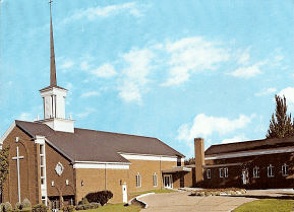|
Builder: Patterson Organ Co, 1982 Originally Austin Organs Opus 1365, 1926 Manuals: 4 Ranks: 36 Pipes: 2052 Action: Electromechanical Notes: 1926: Austin Organs built for Second Presbyterian in Evanston, IL 1982: Moved and reinstalled in Robbinsdale 1998: Digital stops added GREAT ORGAN 16' Violone (digital 8' Principal 8' Rohrflöte 8' Viole d'Gambe 4' Octave 4' Hohlflöte 2' Blockflöte Fourniture III 8' Bombarde Chimes SWELL ORGAN 16' Gedeckt 8' Principal 8' Gedeckt 8' Muted Viole 8' Vox Celeste 4' Octave 4' Gedeckt 2' Octavin Plein Jeu IV 16' Posaune (digital) 8' Trompette 8' Hautbois 8' Vox Humana 4' Clairon Tremolo Celestial Harp CHOIR ORGAN 8' Gemshorn 8' Flute Dolce 8' Flute Celeste 4' Principal 4' Gemshorn 4' Waldflöte 2.2/3' Nazard 2' Blockflöte 1.3/5' Tierce 1.1/3' Larigot 1' Doublette 8' Clarinet Tremolo Celestial Harp Chimes SOLO ORGAN 8' Trompette en Chamade 8' Bombarde Chimes PEDAL ORGAN 32' Contre Diapason (digital) 32' Contre Violone (digital) 32' Contre Bourdon (digital) 16' Subbass 16' Gedeckt (Sw) 16' Violone (Gt) 8' Principal 8' Gedeckt (Sw) 8' Violone (Gt) 4' Choral Bass 4' Flute (Sw) 2' Flute (Sw) 32' Contre Bombarde (digital) 16' Bombarde (digital) 16' Posaune 8' Bombarde 4' Bombarde Clarion Zimbelstern |
 |
 |
|
 |
|
 |
|
|
The Patterson Organ The organ used in the Olivet installation was originally constructed in 1926 by the well known organ building firm of Austin Organs, Inc. The work was Opus 1365, built for the Second Presbyterian Church in Evanston, Illinois. It served in its original home until 1978 when the church united with the First Presbyterian Church in Evanston. It should be noted that this organ was chosen, not as an historic instrument to be preserved, but rather as a source of seasoned and time proven material on which to build a new organ blending the romantic and classic ideals desired by the Olivet congregation. Patterson Organs Inc., the builder, used nineteen of the original ranks of pipes in the new thirty-four rank organ. All of the pipe work was revoiced to blend well with the new principals and mixtures in the Great Division. Some additional pipework was purchased and some was obtained by trading the unused Austin pipes. The Trompette En Chamade was mounted horizontally on the back wall of the balcony to add color to fanfares and trumpet tunes. Two independent electronic systems were acquired for thirty-two foot octaves of Bombarde and Violone to play in the Pedal Division. An interesting deviation from traditional pipe building are the many aluminum pipes in the eight and four foot principals in the Great Division. These pipes were manufactured in Minneapolis by Justin and Mark Matters. The wind chests incorporate mostly electro-mechanical action, although some electro-pneumatic action is used for certain ranks. An electronic digital relay is used to send signals to the wind chests when keys or stop tablets are depressed. The digital relay control center requires only a fraction of the available space in the original four manual console. The mechanical functions of the console were rebuilt. The console exterior was refinished to match the white and cherry décor of the sanctuary interior. Ivory key surfaces were retained and replaced as necessary. The new Patterson organ contains six divisions - Great, Swell, Choir, Bombarde, Pedal, and prepared for Solo Division. Olivet Church hopes to use some of the remaining Austin pipe work at a later date. The majority of the Great Division is located in front of the Swell Division Chamber, newly constructed on the left side of the balcony, and plays on low wind pressure. The Choir Division is located to the rear center of the balcony in a separate chamber. The Pedal Division, Bombarde, and two ranks from the Great Division are on the floor area under the Choir Division. Patterson Organs used the limited space available most efficiently for 2,052 pipes plus Chimes and Harp. |